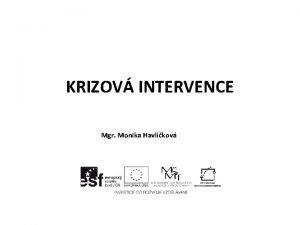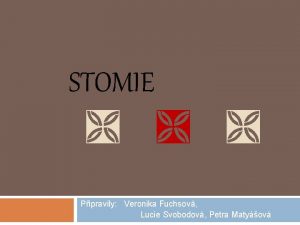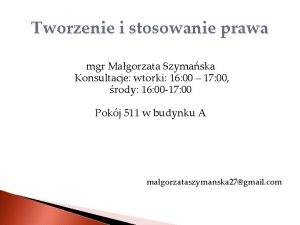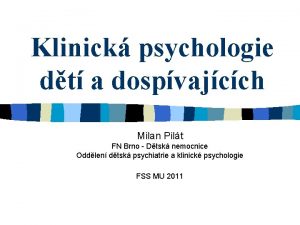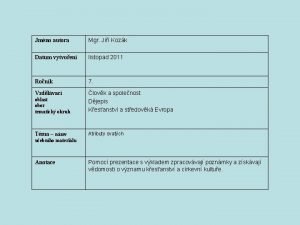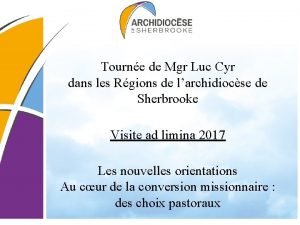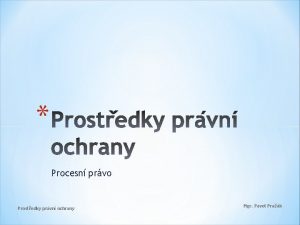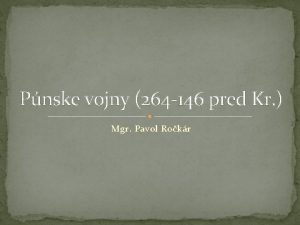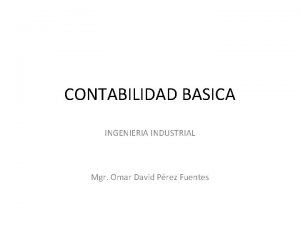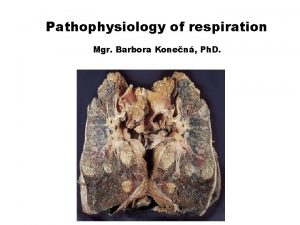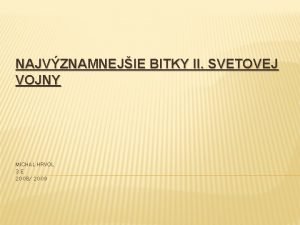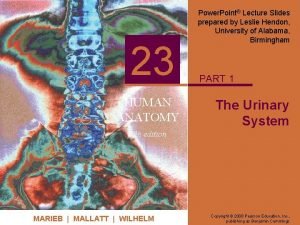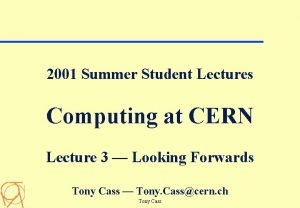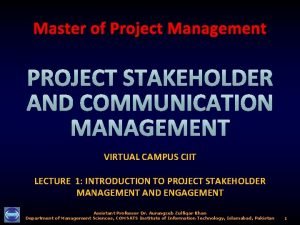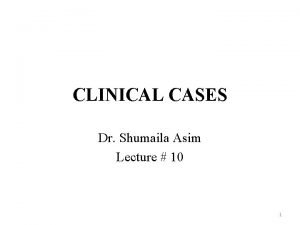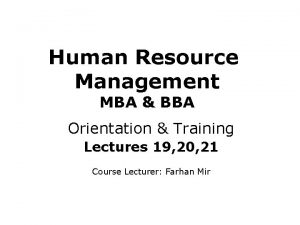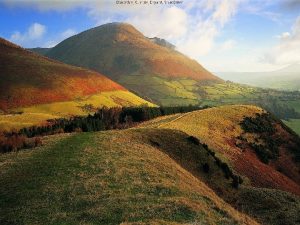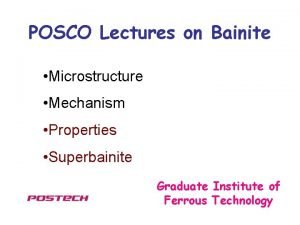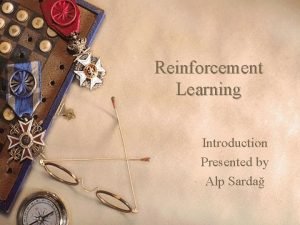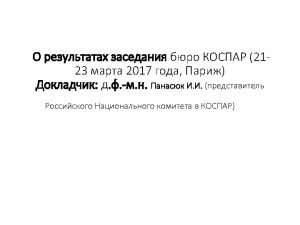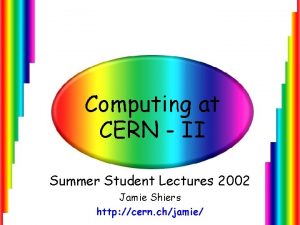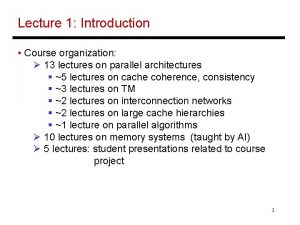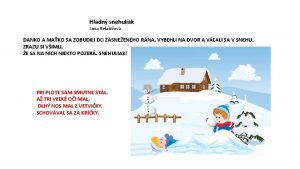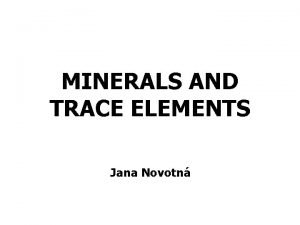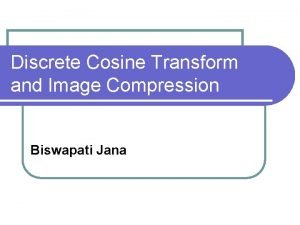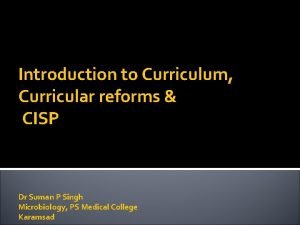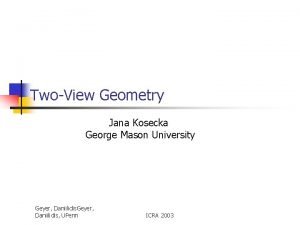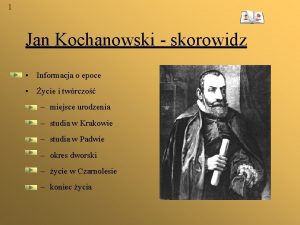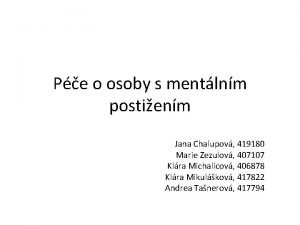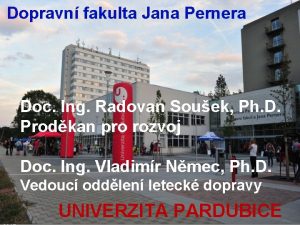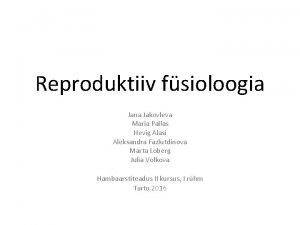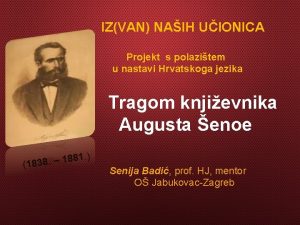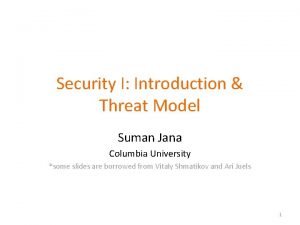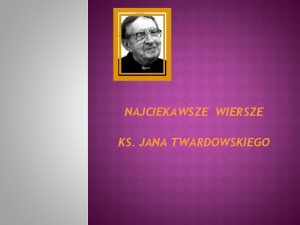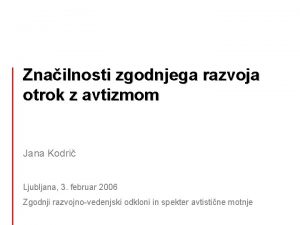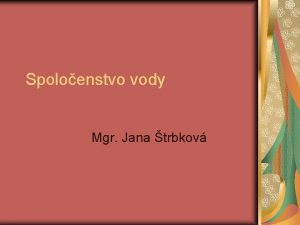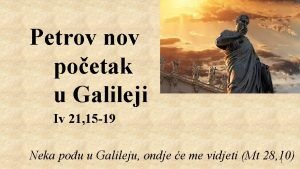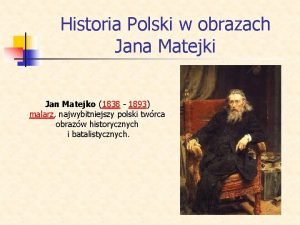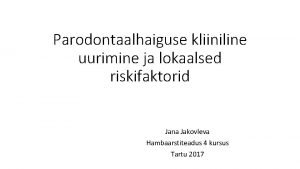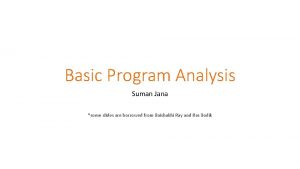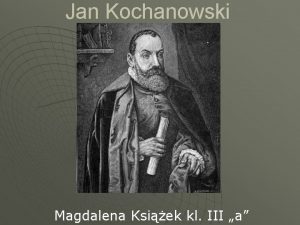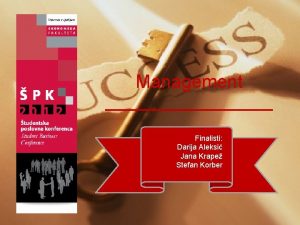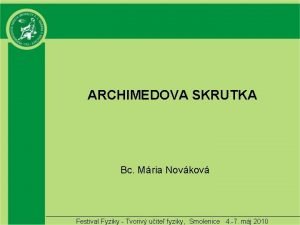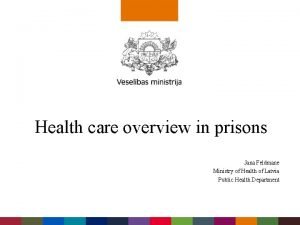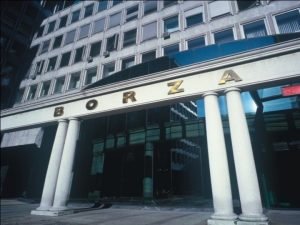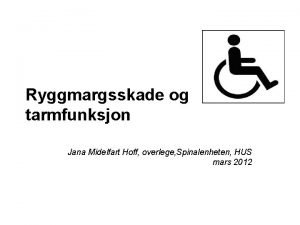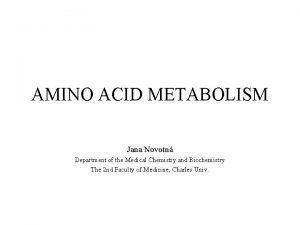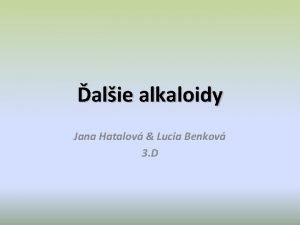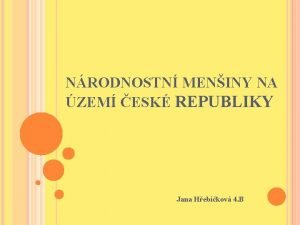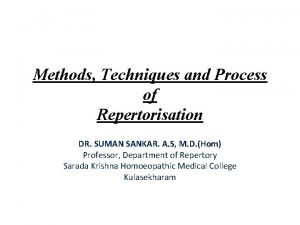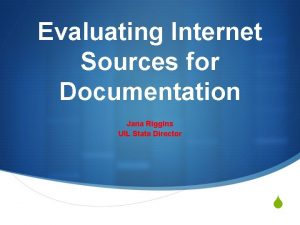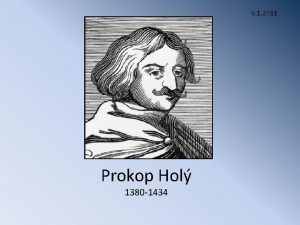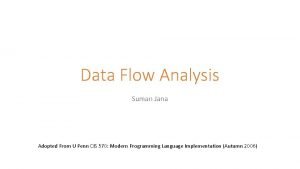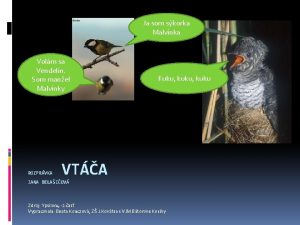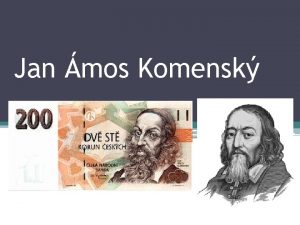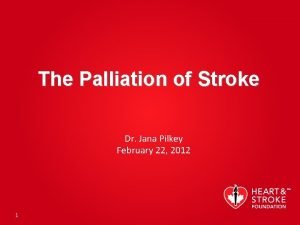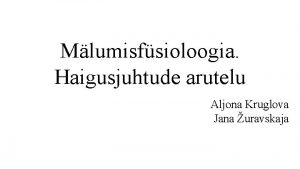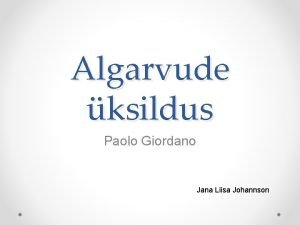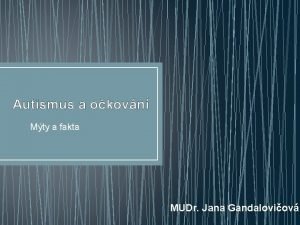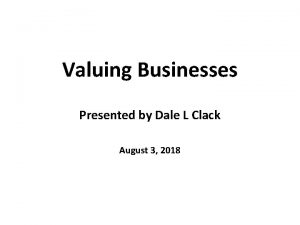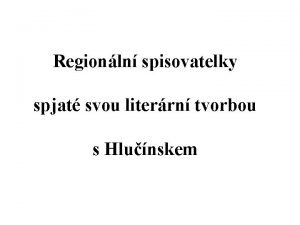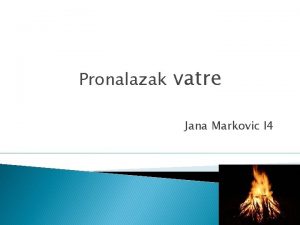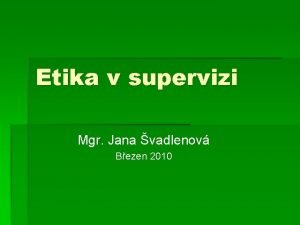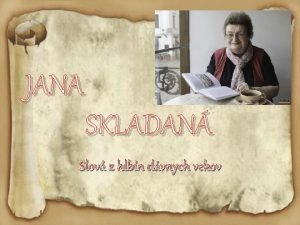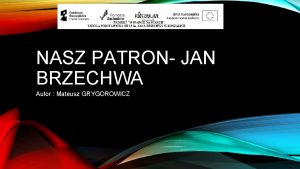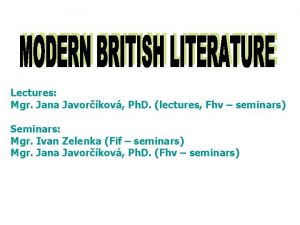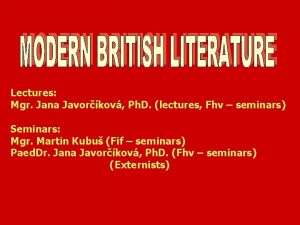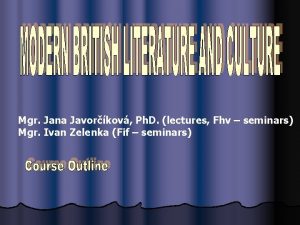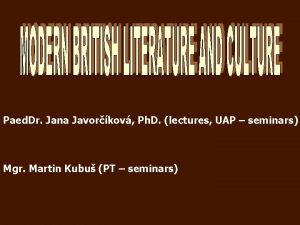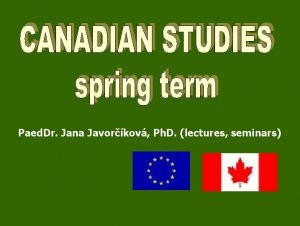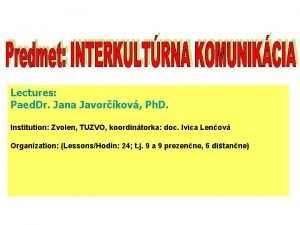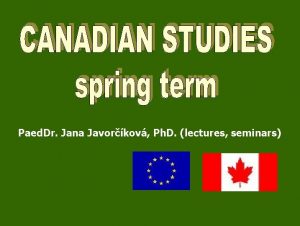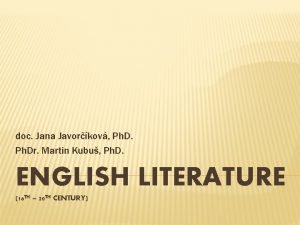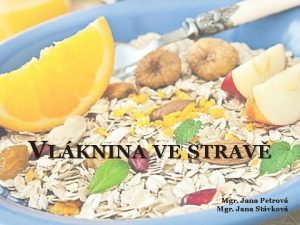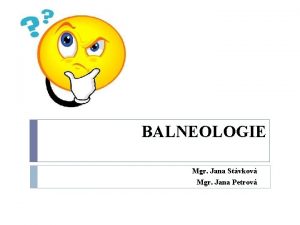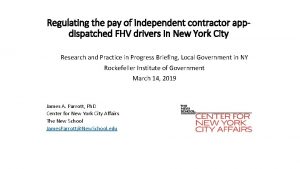Lectures Mgr Jana Javorkov Ph D lectures Fhv




















































































































































- Slides: 148

Lectures: Mgr. Jana Javorčíková, Ph. D. (lectures, Fhv – seminars) Seminars: Mgr. Martin Kubuš (Fif – seminars) Paed. Dr. Jana Javorčíková, Ph. D. (Fhv – seminars) (Externists)

PASSWORD: mbl 1 or mbl 2

THE CULTURAL AND HISTORICAL SETTING OF THE POST-WAR BRITISH LITERATURE WWII BEFORE AFTER ECONOMICS The slump Full employment The economics of the gold standard Keynes´ and Beveridge´s economics John Maynard Keynes: American economist – believed in econ. stimulus William Beveridge: British economist and social reformer

THE CULTURAL AND HISTORICAL SETTING OF THE POST-WAR BRITISH LITERATURE WWII BEFORE AFTER POLITICS Conservative hegemony Labour victory (1945) “Government of men” “administration of things” Labour victory in 1945: Clement Atlee won over W. Churchill (Cons. ) Atlee: Welfare State: “from craddle to grave“ or “from womb to tomb“

THE CULTURAL AND HISTORICAL SETTING OF THE POST-WAR BRITISH LITERATURE WWII BEFORE SOCIETY Class system Aristocratic privilege and glitter “THEM” dependence of women dual system of education AFTER Classless society Egalitarian way “US” feminism of the 60´s tripartite system of education (Butskellism) status revolution BUTSKELLISM: blend of Butler and Hugh Gaitskell´s political thought

BUTLER EDUCATION ACT 1944 – Butler Education Act passed: (Richard Austen Butler, 1902 -82) – compulsory education under 15 – system of sponsorship for the underprivileged students;

Characteristics of British Universities of the 1960’s Formal, traditional, conservative, abstract (virtual character of Oxford) vs. Redbrick provincial universities opposed to Oxbridge

THE CULTURAL AND HISTORICAL SETTING OF THE POST-WAR BRITISH LITERATURE WWII BEFORE AFTER CULTURE common culture equalisation nationalisation decentralisation Americanisation Racial integration Multiculturalism “high vs. low” culture

RESULTS OF BUTLER ACT POSITIVES: l More democratic access to education NEGATIVES: l ANGRY YOUNG MEN

DAVID LODGE (b. 1935) BIOGRAPHY l teacher at the University of Birmingham (1960 – 1987) l His university studies portrayed in a combination of an autobiographical novel, Bildungsroman Out of Shelter, 1970) and H. James’ international novel (setting: London – Heidelberg).

LODGE´S STYLE l master of parody (The British Museum is Falling Down, 1965; Changing Places, 1975); parody of V. W. ; J. J. ; D. H. L; F. K. l Often depicts the Anglo-American cultural gap (Small World, 1984); l motivations: sexual intrigue and the drive for power; l Also wrote theoretical handbooks (The Language of Fiction, 1967) – explaining the methodology of structuralism and empiricism.

Synopsis of Small World Setting: Rummidge, everywhere : late 1970´s –early 1980´s Characters: professors and scholars in humanities (Perssy Mc. Garrigle, Angelica Pabbst, Morris Zapp, Phillip Swallow) Genre and tone: academic romance, ironic

Post-war modernisation of the old class-ridden and antiquated British society END OF LECTURE NO. 1

BRITISH POST-WAR LITERATURE VARIOUS GENRES, TOPICS, STYLES, MOVEMENTS OR MISFITS.

Six periods/groups according to Gilbert Phelps: 1. “Survivors“ of the 1930’s : Virginia Woolf, James Joyce 2. “Already active novelists“ Leslie Paul Hartley 3. Post-colonial or anti-colonial novelists: Paul Scott; James G. Farrell; Hanif Kureishi 4. Female writers: Muriel Spark, Beryl Bainbridge 5. Angry Young Men: John Osborne, J. Wain, J. Braine 6. “Misfits“: John Fowles, David Lodge, Ian Mc. Ewan

SUBJECT CLASSIFICATION: Serious novels: Graham Greene Comic novels: G. Greene Linguistic experimens: Anthony Burgess Traditionalists: August Wilson Detective novels: A. Christie Spy novels: John Le Carré Political allegories: George Orwell Sci-fi: Aldous Huxley

CHRONOLOGICAL CLASSIFICATION: The 30´s: All the Fun: Carpe Diem philosophy of the Jazz Age/Roaring 20´s The 40´s: Extravagance and Reason: war-time escapism The 50´s: Anger and Fear The 60´s and 70´s: Dreams Revived: back to colonial past and its effects

Before we talk about movemements and groups. . . l TWO PROBLEMS: Self-classification of authors 2. POSTMODERNISM - “ownership of the text“ 1.

1. Self-classification of authors: Classification of authors is not easy. Take, for example Alan Sillitoe. He is a “typical“ representative of the literary group called “Angry Young Men“ : 1. Sillitoe himself was born to a working class family but was able to pursue in his studies at a university due to a state sponsorship 2. His main representatives followed the same carreer (e. g. Arthur Seeton) 3. He wrote most of his novels during the highlights of the „Angry Young Men“ period. However, he refused to be labeled an “angry young man“ Alan Sillitoe (Writer) Author of the original novel and scriptwriter of the screenplay for the film. A bestselling novelist for the past 40 years, Alan Sillitoe has lately produced his long-awaited sequel to that first novel, Birthday (Flamingo, 2002).

2. MODERNISM vs. POSTMODERNISM l l MODERNISTS: James Joyce; V. W. ; Edward M. Foster; G. G. ; J. Conrad POSTMODERNISTS: Muriel Spark; Beryl Bainbridge; David Lodge l CHRONOLOGY: l l End of the 19 th ct. – MODERNISM 1920´s – highlights of MODERNISM 1940´s – POSTMODERNISM 1960´s – highlights of POSTMODERNISM l l l POSTMODERNISM: deflection from established rules: double names, characters conventions, form: pastiche style: syntax, sentence structure

POSTMODERNISM – BASIC THOUGHTS MODERNISM: STRUCTURALISM l Language is a system of signs. l Writing is encoding, Reading is decoding. l Text has THE MEANING. l MODERNIST EXPERIMENT: sub-trends: surrealism, old avant-garde POSTMODERNISM: POSTSTRUCTURALISM, DECONSTRUCTION l Language is asystematic. l Every decoding is another encoding. l Text has A MEANING. l l POSTMODERN EXPERIMENT Novel anti-novel, noveau roman Poetry concrete poetry. Drama total theatre LITERARY CRITICISM: Marxist criticism, Feminist criticism, New criticism

Introduction to postmodernism - Diego Rodríguez de Silva y Velázquez LAS MENINAS: THE MAIDS OF HONOUR 1599 -1660

1. Who/what are the people in the painting looking at? 2. How many figures are there? /Notice the sources of light/ 3. Where are you standing? a) A passer by - you c) Another painter b) Somebody else, e. g. a royal couple, infant’s parents, a joker, etc.

A passer by The passer by, be it you or whoever else, represents the OBSERVER of the scene. Metaphorically, he symbolises the READER while the scene represents

How many figures are there? 8 7 9 1 4 2 3 6 5

How many figures are there? MIRROR 9 10 8 7 9 1 2 3 4 MEANING you 6 5

Jacques Foucault: Words and Objects PAINTING SERVES AS A METAPHOR. . . l THE PAINTING = THE TEXT l YOU = THE READER l THE NUMBER OF PEOPLE IN THE PAINTING = THE/A MEANING OF THE PAINTING/ TEXT l SOMETHING THE READER HAS TO ADD BYTHE PROCESS OF THINKING, REFLECTING, ETC.

MODERNISM vs. POSTMODERNISM “Postmodern attitude“can be well illustrated by a paining by Diego Velasquese. Postmodernism is a new trend in arts that expands to many genres, for example to architecture, painting, music, fashion or literature. „

POSTMODERNISM and FASHION Lacroix Goes Giddy for The Kitsch and Kiddy Lacroix likes to dress his women like a fantastic mix between Peter Pan, Alice In Wonderland A Mid-Summer Nights Dream. If you’re looking for a lighthearted dress that oozes childhood sentimentality then Lacroix is your man. I like this dress the best, it so reminds me of Alice – are you ready for the rabbit hole?

POSTMODERNISM and FASHION EXPERIMENT COLAGE OF STYLES (fairy tale vs. ballet vs. surrealist wedding dress) AMBIGUITY EXISTENCIALISM mockery QUESTIONS TRADITIONAL VALUES

POSTMODERNISM and FILM EXPERIMENT COLAGE OF STYLES (detective story vs. love story vs. pulp fiction) AMBIGUITY EXISTENCIALISM PARODY OF A TRADITIONAL GANGSTER FILM QUESTIONS TRADITIONAL VALUES

POSTMODERNISM and MUSIC EXPERIMENT COLAGE OF STYLES AMBIGUITY EXISTENCIALISM QUESTIONS TRADITIONAL VALUES

POSTMODERNISM and ARCHITECTURE EXPERIMENT COLAGE OF STYLES AMBIGUITY EXISTENCIALISM QUESTIONS TRADITIONAL VALUES

. . . meaning is not: • inherent to the text • “given“ or “pre-conceived“ by the writer • controlled by renowned literary critics

. . . meaning is: • WHAT READERS ADD TO THE TEXT • YOUR INTERPETATION BASED ON YOUR UNIQUE PERSONAL EXPERIENCE END OF LECTURE NO. 2

LECTURE NO. 3 ANGRY YOUNG MEN - NOVELISTS 1. WHEN WERE THEY ACTIVE? 2. WHO WERE THEY? 3. WHAT/WHO DID THEY WRITE ABOUT AND AGAINST?

1. WHEN WERE THEY ACTIVE? Active in the 50´s: 1951: Leslie Paul´s autobiography: The Angry Young Men 1956: 8 th May – premiére of Look Back in Anger Characteristics of the period: • “the individual has been devalued, like the pound“ (L. P. Hartley) • people still feeling the hangover of the war • culture was in crisis: narrowness and pessimism of novels John Osborne

2. WHO WERE THEY? The writers themselves and their characters were: • Young, needy, intellectuals • Disillusioned • Displaced • Conformists (contrast to the Beat Generation) Defined themselves against: a blend of homely sensibility; upper class aloofness; liberal politics; avant-garde literary device.

3. WHO/WHAT DID THEY WRITE ABOUT AND AGAINST? Wrote about : An angry young anti-hero: • working class origin • boorish rather than well behaved • rudely angry rather than angry • philistine rather than arty Other dominant topics: • rise of a working class man into the upper middle class • hurdles of education, upbringing and accent

ANGRY YOUNG NOVELISTS – REPRESENTATIVES John Barrington Wain - b. 1925 in the English Midlands graduated from Oxford - professor of poetry at Oxford (1973 – 78) a member of the Inklinks (an Oxford literary group) Hurry on Down, 1953 – a picaresque novel Living in the Present, 1955 The Contenders John Braine b. 1922 in Bedford, Yorkshire; d. 1986 Room at the Top, 1957; Life at the Top, 1962; The Jealous God, 1964; Stay with Me till Morning, 1970; Writing a Novel, 1974; Finger on Fire, 1977.

ANALYSIS OF MAJOR NOVELS BY ANGRY YOUNG MEN: John Wain: Hurry on Down - bestseller Genre: picaresque novel, partly autobiographical Main character: Charles Lumley – university graduate unable to fit in Jack of all trades: driver smuggler bouncer hospital orderly

ANALYSIS OF MAJOR NOVELS BY ANGRY YOUNG MEN: John Brain: Room at the Top – bestseller Life at the Top – sequel Style: open – X-rated in the USA Main character: Joe Lampton – an army vet, town-hall clerk Not unlike Clyde Griffits (American Tragedy, Theodore Dreiser) rich Susan Brown Loves two women poor Alice Aisgill - Seduces and marries her “the running fight between himself and society had ended in a draw“

ANGRY YOUNG NOVELISTS – OTHER REPRESENTATIVES Colin Wilson: The Outsider; Kingsley Amis: Lucky Jim; Allan Sillitoe: Loneliness of the Long Distance Runner Stan Barstow: A Kind of Loving David Storey: This Sporting Life Keith Waterhouse

ANGRY YOUNG MEN - DRAMATISTS John Osborne Life: • (b. 1929 in London) • educated at "a rather cheap boarding school" • former actor in provincial repertory companies • founding member of the "A. Y. M. " group

ANGRY YOUNG MEN - DRAMATISTS John Osborne Characteristics of Osborne's style • primitive dramatic skills; • "kitchen sink" drama; • mood of frustration: anarchic, cynical, nihilistic anti-heroes, social misfits. Major plays and novels • The Entertainer, 1957 - comic Archie Rice; Luther, 1961; • Inadmissible Evidence, 1964; A Patriot for Me, 1965 • Autobiography: A Better Class of Person.

John Osborne Look Back in Anger Richard Burton as Jimmy Porter, the speaker of the generation: "Nobody thinks, nobody cares, no beliefs, no convictions and no enthusiasm“ MAJOR ISSUES: • conflict of generations, social classes and opposite sexes: • conflict of the "sycophantic, phlegmatic and pusillanimous” world of upper class and Jimmy's private, "loose" morality.

JIMMY PORTER: A tall, thin young man about 25. A mixture of sincerity and cheerful malice, of tenderness and freebooting cruelty, restless, importunate, full of pride, a combination which alienates the sensitive and the insensitive alike. Jim hates: Sundays Sunday ironing Pretentionus editorials Sycophantic, pusillanimous people Jim loves: ? ALISON PORTER: Tall, slim, delicate, with surprising reservation in her eyes “I was wrong! I don’t want to be saint. I want to be a lost cause. I want to be corrupt and futile“

WORKING CLASS NOVELISTS Representatives: 1. Working-class origin writers 2. novelists writing about the working class. Allan Sillitoe • b. 1928 in Nottingham • son of an illiterate tannery laborer • father unemployed during Depression - financial problems • left school at 14 - earned money in RAF (Malaya) Style: • versatile author: plays, poems (The Rats and Other Poems, 1960) over 50 essays, children´s books: character of Marmelade Jim • labelled also as an AYM • advocate of the social function of novels (like J. Galsworthy, E. Zola) • realistically portrayed working-class heroes

Allan Sillitoe Style: • versatile author: plays, poems (The Rats and Other Poems, 1960) over 50 essays, children´s books: character of Marmelade Jim • labelled also as an AYM • advocate of the social function of novels (like J. Galsworthy, E. Zola) • realistically portrayed working-class heroes

WORKING CLASS NOVELISTS – A. SILLITOE Major writings: • The Saturday Night and Sunday Morning, 1958 depicts a weekend of a young laborer Arthur Seaton (an anti-hero) local colour • Loneliness of a Long-Distance Runner, 1959 a collection of stories (Uncle Ernest) • Raw Material, 1972 autobiographical features

Allan SILLITOE: Loneliness of a Long-Distance Runner, 1959 Style: – rich in inner monologues – slang – local colour (dialects, regionalisms) - Symbol of protest against those in power – upper classes Shows inner rebelion

Allan SILLITOE: Loneliness of a Long-Distance Runner, 1959 Style: – rich in inner monologues – slang – local colour (dialects, regionalisms) “Come on , Smith“, Roach the sports master called to me, “we don´t want You to be late for the big race, eh? Although I dare say you´d catch them up if you were“. . . So the big race it was, for them, watching from the grandstand under the fluttering Union Jack, a race for the governor, that he has been waiting for, and I hoped he and all The rest of his pop-eyed gang were busy placing big bets on me, hundred to one to win, all the money they had in their pockets All the wages they were going to get for the next five years and the more they placed , the happier I´d be. -

Allan SILLITOE: Saturday Night and Sunday Morning Saturday nights ARTHUR SEATON Sunday mornings • wild parties, • drinking, • dating women married, older – Brenda younger Doreen • repenting – gone fishing Conformist lifestyle: No motivation ambitions, enthusiasm, beliefs. Shows nihilism, resignation of WC

WORKING CLASS NOVELISTS – OTHER REPRESENTATIVES Sid Chaplin • b. 1916, Shildon, Durham - d. 1980 • the son of a coal miner, working in mines at 15 • obtained education from the worker´s Educational Association (Durham) • writing since 1950´s Durham mining community writings: The Leaping Lad, 1964 The Thin Seam, 1950 The Day of the Sardine, 1961 The Mines of Alabaster, 1971 Other writers: Mervyn Jones: Holding On

WORKING CLASS NOVELISTS – OTHER REPRESENTATIVES Sid Chaplin Durham mining community writings: The Day of the Sardine, 1961 ARTHUR HAGGARSTON: – his journey to adulthood – conflict between him and his tedious, repressive employer – the only way out of stereotype: gangs, violence

COMPARISON OF AYM and WCN AYM Jim Porter Jim Dixon (comic) Social rank/ education WC but univer. graduate WCN Smith Uncle Ernest (serious) Little education - criminals Family background Social status Reasons for their frustrations Do have a family/ misfits by choice No family, at the subsistance level Social misplacement anger Impoverished life resignation

COMPARISON OF AYM and WCN WHO HAD A BETTER REASON TO PROTEST? Who did? ANGRY INTELLECTUALS “LOUDMOUTHS“ UNEDUCATED WORKERS, WHO WERE OFTEN CRIMINALISED AND DEMONISED

POSTCOLONIAL LITERATURE IN ENGLISH PAKISTAN CANADA INDIA CEYLON MALAYSIA GUYANA AUSTRALIA, NEW ZEALAND TASMANIA EGYPT, SUDAN, SOUTH AFRICA, NAMIBIA. . . http: //images. google. sk/imgres? imgurl=http: //www. scholars. nus. edu. sg/post/icons/post. gif&imgrefurl=http: //www. scholars. nus. edu. s g/post/&h=255&w=428&sz=26&hl=sk&start=71&tbnid=j. Zzv. TNwk. Mb. OMRM: &tbnh=75&tbnw=126&prev=/images%3 Fq%3 Dicons%2 B %252 B%2 Bliterature%26 start%3 D 54%26 ndsp%3 D 18%26 svnum%3 D 10%26 hl%3 Dsk%26 lr%3 D%26 sa%3 DN

NOVELISTS OF THE 50´s – DISSOLUTION OF THE EMPIRE LECTURE 1. What were the reasons for decolonization and its results? Two reasons for decolonization: 1. Imperialism grew unpopular 2. Finance Milestones in decolonization: 1947 – independent India 1956 – “Suez fiasco” 1960´s – conflicts in Malaya, Cyprus 1982 – Falkland Islands crisis Results of decolonization: 1. loose association - Commonwealth 2. mass immigration (1950´s – 60´s)

POST-COLONIAL WRITINGS 2. Who were the major representatives of post-colonial literature? NOVELISTS OF THE 1950´s: 1. Post-Imperialists – predecessors: Rudyard Kipling (The Jungle Book), Edward Morgan Forster (Passage to India) James Gordon Farrell, Paul Scott 2. Anti- imperialists: Doris Lessing, Nadine Gordimer

Doris Lessing l l l (b. 1919, Persia – present-day Iran - ) Childhood spent in Rhodesia, Africa Exposed to contradictions, illusions and pessimism Style: l l “. . . English writer without English tradition“ realism: ambiguous nature of African-English co-existence l l 1979 – psychoanalysis, (The Golden Notebook); “space fiction“ The Grass is Singing, 1950 Children of Violence African Stories, 1961

Doris Lessing The Grass is Singing, 1950 Collection of stories: Little Tembi, No Witchcraft for Sale European rationalism (Cartesian compulsion to think rationally African English: Baas, Missus, Boss Boy VS. African rituals (faith healing, taboo and code, miracles)

POST-COLONIAL WRITERS: James Gordon Farrell • (b. 1935, Liverpool – 1979) • Spent a great deal of life abroad: France, North America • Won the Booker Prize in 1973 Style: – “Blended English sensitivity and Indian exoticism” – topics: Hindustan life, trappings of civilisation The Siege of Krishnapur; 1973 A Girl In the Head The Singapore Grip, 1978 The Hill Station, 1981 Sabres and Dust by Chris Collingwood British light cavalry and horsemen of Skinners Horse fight Pindarn and Maratha 1826. In 1827 Skinners Regiment was known as the 1 st Regiment of Local Horse and had just been awarded the Battle Honour 'Bhurtpore' for its part in the reduction of the fortress at Bharatpur. Skinner himself being made a companion of the Order of the Bath.

POST-COLONIAL WRITERS: James Gordon Farrell The Siege of Krishnapur; 1973 – depicts 1857 – Sepoy rebellion in India – the English struggling for their way of life The Singapore Grip, 1978

POST-COLONIAL WRITERS: Paul (Mark) Scott ( 1920 - d. 1978) -“brings to India the fractious personality of the Westerner” India – a Lost Paradise, Englishman’s India Raj Quartet: -The Towers of Silence ; -The Day of the Scorpion -The Jewel in the Crown; -Staying On Officer Skinners Horse 1905 by Mark Churms The Founder's Church of St. James, Dehli, illustrates its association with this famous regiment of Bengal Lancers.

TETRALOGY BY PAUL SCOTT

LEGACY OF POST-COLONIAL WRITERS: • CRITICISM OF COLONIALISM AND ITS PROPAGANDA • CRITICISM OF DIRECT AND INDIRECT IMPACT OF COLONIALISM COLONIAL VISUAL ARTS: • pictoresque • romantic • idealised

LEGACY OF POST-COLONIAL WRITERS: • CRITICISM OF COLONIALISM AND ITS PROPAGANDA • CRITICISM OF DIRECT AND INDIRECT IMPACT OF COLONIALISM COLONIAL VISUAL ARTS: The British portrayed as (naturally) superior

VISUAL ARTS Painters often showed the Indians in subordinate positions

VISUAL ARTS AND PROPAGANDA http: //posters. nce. buttobi. net/

Rudyard Kipling White Man's Burden Take up the White Man's burden-Send forth the best ye breed-Go bind your sons to exile To serve your captives' need; To wait in heavy harness, On fluttered folk and wild-Your new-caught, sullen peoples, Half-devil and half-child. l 1865 -1936

Post-colonial literature reacts to myths, halftruths and the autocratic view of the world represented by the colonial literature

POST-COLONIAL WRITERS: PROPAGANDA AND CRITICISM OF COLONIALISM IN POST-COLONIAL WRITINGS 1. Direct Criticism: Doris Lessing Nadine Gordimer 2. Indirect criticism: Paul Scott In his novel The Jewell in the Crown, Scott pays attention to the propaganda taught at British colonial schools, run by British teachers. Except for basics of algebra and reading, teachers often idealised the relationship bethween India and Great Britain was depicted as a “mother“, taking India under her protective wing, promoting education, religion, hygiene and culture. Indians, on the other hand, were depicted as willing to offer their country as a gift to their “Mother Country“, Britain. In visual arts, many painters also depicted the harmonic relationship and obedience or submissiveness of the Indians.

POST-COLONIAL WRITERS: PROPAGANDA AND CRITICISM OF COLONIALISM IN POST-COLONIAL WRITINGS 1. Direct Criticism: Doris Lessing Nadine Gordimer 2. Indirect criticism: Paul Scott In his novel The Jewell in the Crown, Scott pays attention to the propaganda taught at British colonial schools, run by British teachers. Except for basics of algebra and reading, teachers often idealised the relationship bethween India and Great Britain was depicted as a “mother“, taking India under her protective wing, promoting education, religion, hygiene and culture. Indians, on the other hand, were depicted as willing to offer their country as a gift to their “Mother Country“, Britain. In visual arts, many painters also depicted the harmonic relationship and obedience or submissiveness of the Indians.

POSTCOLONIAL AND POSTIMPERIAL LITERATURE IN ENGLISH Salman Rushdie “Novels are not to lay down rules but to ask questions. “ l l l b. in Bombay, India to a prosperous family b. in 1947, the year of political changes in India Moved to England Received M. A. from King´s College, Cambridge Worked as an actor, free-lance advertising copy-writer 1989 - “FATWA” - Condemned by Ayatollah Khomeni to death

FATWA – SENTENCE TO DEATH I inform all zealous Muslims of the world that the author of the book entitled The Satanic Verses— which has been compiled, printed and published in opposition to Islam, the Prophet, and the Qur'an— and all those involved in its publication who were aware of its content, are sentenced to death. I call on all zealous Muslims to execute them quickly, wherever they may be found, so that no one else will dare to insult the Muslim sanctities. God Willing, whoever is killed on this path is a martyr.

EFFECTS OF THE SATANIC VERSES l Japanese translator Hitosh Igorashi stabbed to death l Italian translator Ettore Capriolo – seriously injured l Norweigan translator William Nygaard hardly survived assassination attack

Salman Rushdie’s Style: l Influenced by J. Joyce l Combines fantasy and magic l Uses satire l Attacks religious bigotry l Criticism: Incoherent melange of plots, themes, characters

The Satanic Verses – issues: l Ispired by the life of Muhammad l Attempts to be the “false part of Qur’an“ l Uses MAGIC REALISM (characters of angels, demons, hybrids. . . )

Main characters: Indian expatriates in England GIBREEL FARISHTA Bollywood star SALADIN CHAMCHA Voice-over in Indian films PLANE CRASH ARCHANGEL GIBREEL schizophrenia DEVIL Falls into hallucinations Understands his Indian identity

Theme of The Satanic Verses: l. . . “migration, metamorphosis, divided selves, love, death, London and Bombay. „ l Other concepts: faith BLASPHEMOUS fanaticism revelation justifying God’s existence

Rushdie writes of the title of Satanic Verses: You call us devils? It seems to ask. Very well, then, here is the devil's version of the world, of "your" world, the version written from the experience of those who have been demonized by virtue of their otherness. Just as the Asian kids in the novel wear toy devil-horns proudly, as an assertion of pride in identity, so the novel proudly wears its demonic title. The purpose is not to suggest that the Qur'an is written by the devil; it is to attempt the sort of act of affirmation that, in the United States, transformed the word black from the standard term of racist abuse into a "beautiful" expression of cultural pride.

Concepts: NEWNESS – CHANGE (IDENTITY POLITICS): FOREIGNERS –ALIENS – UNSPOILED NATIVES CENTRAL AND MARGINAL CULTURES Other novels by Salman Rushdie Novels: l l The Book of the Pir, 1971 Midnight Children, 1981 Shame, 1983 The Satanic Verses, 1989

POSTCOLONIAL AND POSTIMPERIAL LITERATURE IN ENGLISH Kazuo Ishiguro “What is history to a nation, memory is to the individual” l l b. in 1954 in Nagasaki, Japan moved to Britain in 1960 depicts cultural gap between two cultures graduated from the Univ. of East Anglia, lives in London

Ishiguro’s style: “It is perhaps a sign of my advancing years, that I have taken to wandering into rooms for no purpose. ” (Masuji Ono, in: Artist of the F. V. ) Characters wander through the “rooms“ of their memories (ellipses, meanders) l Distortion of the past and present l Ironical deceptions of memory l

Ishiguro’s major novels Novels: l l A Pale view of Hills, 1982 An Artist of the Floating World, 1985 The Remains of the Day, 1989 The Unconsoled, 1995 Concepts: l FLOATING WORLD – “the night time of pleasure, entertainment and drink. ” l JOURNEY – the “journey“ motif

The Remains of the Day l Set in pre and post-war Britain l Narrator: aging butler Stevens who serves for Lord Darlington Mrs Kenton – love subdued to duty THE ESSENCE OF BRITISHNESS Lord Darlington – abosolute loyalty Stevens’ father – latent love Mr. Farraday – new American master

The Prophet´s Hair Set in: India, 19 Characters: wealthy moneylender Hashim, his son Atta, daughter Huma Plot: Hashim finds a relic, decides to keep it. Instead of good fortune, it brings his family ill fortune: Hashim turns a bigot, forces his family to ultraorthodox Muslim life. Contribution: l Developing cultural awareness: shikara, khichri, phial, purdah, mulahs (no endnotes, explanation) l Combines fantasy and magic (reclic = prophet´s hair – its miraculous powers) l Satire of religious bigotry (countereffects of the relic, mullahs wanted to lynch Atta for the loss of relic, Sheikh´s crippled children were healed which “ruined them for life“)

LITERATURE OF THE 60’ s , 70’s AND 80’s • After experiment with new topics (post-imperialism) • Experiment with the form Saga Roman fleuve Stream novel River novel Bildungsroman

Saga Novel l a narrative or a tale of heroic achievements or extraordinary or marvellous adventures, e. g. Beowulf l a narrative about the life of a large family, written over a long period and linked together by a character or place, e. g. Forsyte Saga

OTHER EXPERIMENTS WITH FORM Roman Fleuve – stream novel – “river novel“ a term used for a series of novels, each of which exists as a separate novel but all of which are related because the characters reappear in each succeeding work. l roman fleuve was established by E. Zola, H. Balzac and M. Proust l the most popular variants: trilogy, tetralogy l Bildungsroman - the term used widely by German critics, referring to a novel which is an account of the youthful development of a hero or heroine (David Lodge: Out of Shelter)

NOVELISTS OF THE 50´s ANTHONY POWELL, ANGUS WILSON, C. P. SNOW Novelists of the 50´s – achieved considerable reputation in the 50´s – unique category l Common Features: l satiric interest in the changes in the Great Britain in the 50´s and 60´s l disgust with the spread of Western civilisation l genre (roman fleuve)

NOVELISTS OF THE 50´s ANTHONY POWELL, ANGUS WILLSON and CHARLES PERCY SNOW l stories of “upper-class hard-heads“ l started publishing in the 30´s

ANTHONY POWELL (1905 - 2000) educated at prestigious Eton Balliol College (Oxford) l a friend of Evelyn Waugh, Graham Greene l started as a film script-writer l critic and book reviewer for: the Daily Telegraph; l Nicolas Poussin’s picture which gives name to the novel the Times Literary Supplement; Punch; the Spectator Style: universal: - 4 volumes of memoirs 3 volumes of diaries 2 volumes of literary criticisms

ANTONY POWEL’S MAJOR WORKS: Novels: l l l Afternoon Men, 1931 Venusberg, 1932 A Dance to the Music of Time l l l slowly developing narrative (narrator: Nicholas Jenkins), set between the 20´s and 50´s a chronicle of British upper middle class a fictionalised war memoir a prose elegy for the decline and fall of a ruling class

A Dance to the Music of Time 1. A Question of Upbringing 2. A Buyer´s Market 3. The Acceptance World 4. At Lady Molly´s 5. Casanova´s Chinese Restaurant 6. The Kindly Ones 7. The Walley of Bones 8. The Soldier´s Art 9. The Military Philosophers 10. Books do Furnish a Room 11. Temporary Kings 12. Hearing Secret Harmonies

A Dance to the Music of Time Metaphor: Conformism of those who „dance to the music of time“ Parody of English political, social and military life

A painting by Nicolas Poussin Seasons hand in hand Symbolising: • Passing of time, • Human mortality Dance Symbolises Partmership – its twists and turns

Charles Percy Snow Baron Snow of Leicester (1905 - 1980) educated as a chemist and physicist at the Univ. of Leicester l held important positions in the British Government l Style: -rational, atheistic, - scientifically exact, influenced by the genre of detective stories - conflict between the sciences and the humanities (The Two Cultures)

NOVELS BY CHARLES PERCY SNOW Strangers and Brothers, 1940 – 1970 - eleven novels in the series - narrated by 'Lewis Eliot'. - follows his life and career from humble beginnings in an English provincial town, to London lawyer, to Cambridge don, to wartime service in Whitehall, to senior civil servant and finally retirement. l l The Masters, 1951 The New Men, 1954 Last Things, 1970

ANGUS WILSON l b. 1913 Style: l -restless experimentation with: l REALISM (Hemlock and After, 1952) l FABLE, ALLEGORY (The Old Man at the ZOO, 1961) Topics: l criticised SOCIETY ; society understood holistically l favoured NATURE – source of stable values Characters: (3 groups) l PRINCIPAL PLAYERS l SUPPORITNG ROLES l ADDITIONAL CAST

NOVELISTS OF THE 50´s - GRAHAM GREENE b. in 1904 to the family of a Headmaster; l studied at Balliol College, Oxford; l editor of the Oxford Outlook, The Times, The Spectactor; l during WWII an employee of the Ministry of Information. l Style: 1. Catholicism; 2. Exotic settings (Cuba, Estonia); 3. Spy novels, double agents; 4. Greenland.

GRAHAM GREENE’S STYLE Greenland l – the term describing specific atmosphere in Greene´s novels: “… the sweat and infection, the ill-built town which is beautiful for a few minutes at sundown, the brothel where all men are equal, the vultures… the snobbery of the 2 nd class public schools, the law which all can evade, the everpresent haunting underworld of gossip, spying, bribery, violence and betrayal…“ Evelyn Waugh l Technique of writing/narration: Camera Eye – recording significant details (absolutely objective narrative, no judgemental voice)

HAVANA. . . the sweat and infection, the ill-built town which is beautiful for a few minutes at sundown, the brothel where all men are equal, the vultures… the snobbery of the 2 nd class public schools, the law which all can evade, the everpresent haunting underworld of gossip, spying, bribery, violence and betrayal…“ Evelyn Waugh

GRAHAM GREENE’S MAJOR WORKS Novels: Early Years: 1929, The Man Within l Pre-WWII novels: l l l 1938, Brighton Rock 1939, The Confidential Agent 1940, The Power and the Glory Post-WWII novels: 1948, The Heart of the Matter 1951, The End of the Affair 1955, The Quiet American 1958, Our Man in Havana 1969, Travels with my Aunt 1973, The Honorary Consul

Our Man in Havana l Parody of a spy novel l Based on G. G’s experience during WWII l Set in Cuba l Story of an underdog Wormold l Selling vacuum cleaners mistaken for military plans of nuclear bombs l Becomes Secret Agent 5920015

a) Objective narrator b) Subjective narrator c) 1 st person narr. d) 3 rd person narrator l There were eight Japanese gentlemen having a fish dinner at Bentley´s. They spoke to each other rarely in their incomprehensible tongue, but always with a courteous smile and often with a small bow. All but one of them wore glasses. Sometimes a prety girl who sat in the window beyond gave them a passing glance, but her own problem seemed too serious for her to pay any real attention to anyone in the world except herself and her companion.

LITERATURE OF THE 50´S AND 60´S - EXOTIC NOVELS • 50’s – 60’s – Period of the “Dreams revived“ • Inspiration by the colonial past, (Lawrence Durrell) exotic countries, (William Golding) utopia, dystopia and sci-fi (Eric Arthur Blair – George Orwell)

Lawrence Durrell (1912 - 1990) b. in Jullundur, northern India to his English father and Irish-English mother l result: inclination toward “Tibetan mentality“; mixed nationality l sent to England at the age of 11 to be formally educated there l missed Southern climate and way of life, moved to Corfu l fled Greece in 1941 just ahead of Nazi army l Press attaché in the British Information Office in Alexandria, Egypt (Belehrad and Rhodes) l A teacher of English literature in Cyprus l Deeply touched by the death of his wife and daughter l

Lawrence Durrell (1912 - 1990) Style: l Influenced by Henry Miller (naturalism), H. D. Lawrence (sexual openness) l Fascination for the Far East (oriental folklore, habits) l Modernist fiction (philosophical point of view) Novels: Pied Piper of Lovers (pseudonym: Charles Norden) Panic Spring, 1937 Bitter Lemons

The Alexandria Quartet: Justine, 1957 Balthazar, 1958 Mountain Olive, 1958 Clea, 1960 l Subject: the expression of love: pure love, incest, rape, infant prostitution, lesbian love, homosexuality. l Specific expressions of L. G. Dartley´s love to Justine (passion), Melissa (affection), Clea (healing love), Mount Olive (friendship). The Revolt of Aphrodite: 1. Tunc, 1968 2. The Avignon Quintet, 1974 -85

William Golding (1911 - 1993) l l b. in Newquay, Cornwall graduated from Oxford University during WWII joined the military service 1983 - Nobel Laureate in Literature Style: l influenced by Greene´s religiosity: original sin, evil in people l Interested in existential rather than national issues: “I should have thought that a pack of British boys… would have been able to put up a better show than that”. called his writings “fables“ or “myths“; also writing moral allegories: post Darwinist and post Wellsian pessimism l excessively using symbolism l

Novels by W. Golding l Poems, 1934 EVIL IN MEN l The Inheritors, 1955 l Pincher Martin, 1965 OUTSIDERISM l Free Fall, 1959 CORRUPTION OF POWER l The Spire, 1964 l The Lord of the Flies, 1954 INNER SAVAGERY SOCIAL RULES AND ABSENCE THEREOF

Novels by W. Golding EVIL IN MEN OUTSIDERISM CORRUPTION OF POWER INNER SAVAGERY SOCIAL RULES AND ABSENCE THEREOF l „Man produces evil like a bee produces honey“ l An outsider often draws attention away from predators’ mistakes l People need an absolute monarch

Lord of the Flies l Subject: collapse of civilisation: transition from civilised to barbaric Inspired by Robert Ballantyne´s Coral Island (1858), Jules Verne, Daniel Defoe and sci – fi l l Setting: unspecified - Indian – Pacific Ocean – time: WWII (? )

Lord of the Flies = inborn evil in people l Nemesis (in Greek, Νέμεσις), was the spirit of divine retribution against those who succumb to hubris, vengeful fate personified as a remorseless goddess. l The name Nemesis is related to the Greek word νείμειν, meaning "to give what is due". The Romans equated one aspect of Greek Nemesis, which might be interpreted as "indignation at unmerited advantage", as Invidia (Aronoff 2003). l Nemesis is now used as a term used to describe one's worst enemy, normally someone or something that is the exact opposite of oneself but is also somehow similar. For example, Professor Moriarty is frequently described as the nemesis of Sherlock Holmes.

Post Darwinist and post Wellsian pessimism Charles Darwin Origin of Species (1869) The Survival of the Fittest Herbert Spencer had published The principles of biology in 1864. In that he referred to 'survival of the fittest' twice l Lo. F shows the downfall of civilisation (from civilised to barbaric)

Golding’s Post Darwinist and post Wellsian pessimism Herbert George Wells „The Father of Sci-fi“ Author of: The Time Machine The War of Worlds The Invisible Man The Island of Doctor Moreau Believed that technology does not make a man happier

Symbolism in Lord of the Flies l l l l l English cathedral choir schoolboys - microcosm Piggy, glasses: intelligence Ralph, the conch – democracy Simon – Jesus Roger – Evil, Satan Jack – anarchy The island – a microcosm The beast – evil, residing within everyone Lord of the Flies – the Devil l l Other authors: Malcolm Lowry: Under the Volcano

BRITISH POST-WAR POETRY SEVERAL MOVEMENTS EMERGED THE MOVEMENT THE REVIEW THE GROUP THE MARTIANS THE UNDERGROUND TED HUGHES SEAMUS HEANEY

THE MOVEMENT l l - dominated in the 40's - 50's; - manifesto of THE MOVEMENT: collections: "Poets of the 50's", 1955 and "New Lines", 1956 P. Larkin: I believe a poet has to enjoy writing poetry and the readers enjoy reading it, or they are both wasting their time. (The Times, 1964).

I had suggested, in exasperation, that he finds Something other to write about the moon, and flowers and birds, and temples, And the bare hills of the once holy city Through the leprous lakes of mud. (Changing the Subject). The poet Should seek more serious topics Struggle with life

Artistic manifesto of the Movement Influences: W. Butler Yeats; W. H. Auden; Edwin Muir; Philosophy of the Movement * Disillusionment * Empirism * Subjectivity, intimacy, privacy * Intellectualism * Specific target: poets, churchgoers, mourners * Rational, logical language * Representatives: educated, Oxbridge graduates

Intimacy Sharp observations And why should this chain of miracles be easier to believe Than that my darling should come to me as naturally As she trusts a restaurant not to poison her? " on life Existential topics This man I knew Only a little, by his death Shows me a love I thought I lacked. . . For finished work, like answered prayer, makes death taste sweet. Vivid SIMILES

MEMBERS OF THE MOVEMENT 1. Robert Conquest “A World of Difference“, 1955; "Arias from a Love Opera", 1969 "Forays", 1979 2. Philip Larkin: Whitsun Weddings 3. D. J. Enright 4. Elisabeth Jennings “Poems“, 1953; “A Way of Looking“, 1955; A Sense of the World" 5. Kingsley Amis Poems: "The End" 6. John Wain "Mixed Feelings", 1951; "A Word Carved on a Sill", 1956; Weep before God, 1961 7. Thom Gunn "On the Move", 1966; "The Sense of Movement" 8. John Holloway - literary criticism 9. Donald Davie - literary criticism

PHILIP LARKIN l l l - b. 1922 in Coventry, died 1985; - studied at Oxford, St. John's - librarian in Belfast, Leicester Collections: “The North Ship", 1945 “The Less Deceived“, 1955 “The Whitsun Weddings“, 1964 “High Windows“ Style: Days What are days for? Days are where we five. They come, they wake us Time and time over They are to be happy in: Where can we live but Ah, solving that question Brings the priest and the doctor In their long coats Running over the fields.

RHETORIC QUESTION ANAPHORA Days MOTIFS OF What are days for? PANTA REI Days are where we live. They come, they wake us Time and time over They are to be happy in: METAPHYSICAL Where can we live but FOUNDATIONS Ah, solving that question Brings the priest and the doctor In their long coats Running over the fields. TABOO QUESTIONS

DENNIS JOSEPH ENRIGHT - b. 1920 Style: comic, funny verses Collections: l "The Laughing Hyena", 1953 l "Bread Rather than Blossoms", 1956 l “The Old Adam", 1965 l "Unlawful Assembly", 1968 l “The Terrible Shears",

MINOR MOVEMENTS AND LITERARY TRENDS: THE UNDERGROUND • Loose groups also called “The Liverpool Poets” • Representatives: Adrian Henri, Roger Mc. Gough • TOPICS: Criticism of “the Establishment” Formed since the 1960´s • Influenced by the Beat Generation, jazz, William Blake, dadaism, surrealism • Collections: Love, love, 1968; Children of Albion, 1969

THE REVIEW l - Their manifesto: magazine l - Reaction to the Movement l - Confessional poetry and dramatic lyrics of Alfred Alvarez

THE MAVERICKS l - Opposition to the Movement l - their anthology: The Mavericks l - representatives: Ian Silkin (Nature with Man, 1965) l TONE: reflexive, meditative poetry about the North of England its nature

THE MARTIANS or THE MARTIAN SCHOOL l - collection: A Martian Sends a Postcard Home, 1979 l - representatives: Craig Raine

SEAMUS HEANEY “. . . poetry as revelation of the self to the self, as the restoration of the culture to itself, poems as elements of continuity. . . ” (1976) l l - b. in Ireland (Conn Derry), 1939 - studied in Belfast at Queen´s University - teacher, later the Head of the Department in Dublin 1995 – awarded the Nobel Prize Style: l - prolific, near-demonic poet l - simple but strong l - anti-human l - reflections of the experience of human cruelty l - psychic drama

SEAMUS HEANEY’s APOLITICAL POETRY 1. APOLITICAL POETRY: l Traditionalist: images of farms, diligence, animals, nature l Language: robust, uses dialects, archaisms, experiments with assonance l l Prosody: unrhymed, American free verse form inspired by neonaturalism of Ted Hughes, Robert Lowell Collections: - Death of a Naturalist, 1966 Wintering Out The North, 1975 Field Work, 1979 l

SEAMUS HEANEY’s POLITICAL POETRY 2. POLITICAL POETRY l l influenced by Patrick Ravanagh rooted in Heaney´s Irish Catholic origin (Ulster Catholics) l l criticises bigotry of the Protestant Extremists Military Images: Trout, Rookery Collections: Whatever You Say, Say Nothing North, 1975

(Edward James) Ted Hughes b. 1930 in the North of England (West Yorkshire); l Studied at Cambridge; interested in folklore, D. H Lawrence, Shakespeare, Dylan Thomas; l Many unusual jobs l 1956 – married to a U. S. poet Sylvia Plath; l founded Arvon foundation; l died 1984. l

Ted Hughes’ style: l l l individual; middle-English poetry – north-English dialect; philosophical topics, questions; neo-naturalist; 1 st person narrator: „I sit in the top of the world, my eyes closed“. Topics/Themes: l brutality vs. vitality : l Symbolism: of Jaguar, Hawk, Fox, Cat, Pike; pigs, apes, parrots l Death vs. life: symbolism of animal world, war l Horror, roughness: - ”silhouette of horror“, “enraged jaguar”; l “sudden sharp hot stink of fox” l Determinism; l Exercise of power

Controversial poetry of Ted Hughes Exercise of power: I kill where I please because it is all mine. . . Nothing has changed since I began. My eye has permitted no change. I am going to keep things like this. (Hawk Roosting) Collections of poems: l - The Hawk in the Rain, 1957; l l - Lupercal, 1960; - Gandette, 1977; - Cave Birds, 1978; - Moortown, 1979.

Written test l Content: lectures, seminars, Look Back in Anger, Lord of the Flies, doplňujúce texty na skúšku (see: web page) l FORM: multiple choice, gap filling, essay

Sample task 1 1. Who wrote Dance to the Music of Time? a) b) c) d) e) John Osborne Baron Snow of Leicester Doris Lessing Charles Percy Snow None of these

Sample task 2 1. What do Allan Sillitoe, Kingsley Amis and Sid Barstow have in common? a) b) c) d) e) They were awarded the Nobel prize They all use metaphors in the titles of their novels They all use the setting of Greenland They are working class novelists None of these

Task 3 – Essay - Points for: l Cultural and historical context l Correct information from the piece (names, setting, plot) l Active use of the story to illustrate your point l Independent thinking

Write a paragraph on the status revolt of a female protagonist in LBA The character in LBA who represents the status rebellion is Alison Redfern, the daughter of an India veteran, colonel Redfern. She was born to a privileged upper class, however, for dubious reasons she decided to marry below her standard. She married a working class representative, Jim Porter, who in spite of his education could not find a proper job and worked in a candy stand. He represents a „typical“ angry young man, product of Butler’s educational law of 1944 which left many overqualified young people unemployed. That, of course, made Jim irritated and oversensitive and he often relieved his anger on Alison. Thus Alison, as a representative of the upper class ended up in a depressive relationship with an upset and conformist young man. It is a good question what made Alison rebell against her own class and parents – was it just a generation gap, natural teenage protest against authorities, or more serious reasons? Or was it love that brought her to a tiny attic room? John Osborne did not really answer the question in the play and let the spectactor wonder about Alison’s true motivation.

List of Sources Photos and Images: Books http: //images. google. sk/imgres? imgurl=http: //www. wickedlady. com/tins/images/literature. jpg&imgrefurl=http: //www. wickedlady. com/tins/liter ature. html&h=348&w=300&sz=36&hl=sk&start=18&tbnid=q. Kxv. Zv 6 m. YZBb_M: &tbnh=120&tbnw=103&prev=/images%3 Fq%3 D%2 Bliterature %26 svnum%3 D 10%26 hl%3 Dsk%26 lr%3 D%26 sa%3 DG www. newtherapist. com/diagnosis 12. html Farrell, J. G. http: //images. google. fr/images? svnum=10&hl=sk&lr=&q=j. +g. +farrell+%2 B+writer&btn. G=H%C 4%BEada%C 5%A 5 Greene, Graham http: //en. wikipedia. org/wiki/Graham_Greene Ishiguro, Kazuo http: //images. google. fr/images? q=kazuo+ishiguro&hl=sk&btn. G=Vyh%C 4%BEad%C 3%A 1 vanie+obr%C 3%A 1 zkov Osborne, John http: //images. google. fr/images? q=john+osborne&hl=sk&btn. G=Vyh%C 4%BEad%C 3%A 1 vanie+obr%C 3%A 1 zkov Postmodernism http: //www. colorado. edu/English/courses/ENGL 2012 Klages/pomo. html Web-pages: Rushdie, Salman http: //images. google. fr/images? q=salman+rushdie&hl=sk&btn. G=Vyh%C 4%BEad%C 3%A 1 vanie+obr%C 3%A 1 zkov Sillitoe, Allan http: //images. google. fr/imgres? imgurl=http: //www. open 2. net/open 2 static/source/file/root/45/58/188077/allan_sillitoe. jpg&imgre furl=http: //www. open 2. net/castandcrew/snsm. html&h=134&w=134&sz=30&hl=sk&start=4&tbnid=TBt 2 TYSu. Np. OLa. M: &tbnh=92 &tbnw=92&prev=/images%3 Fq%3 Dallan%2 Bsillitoe%26 svnum%3 D 10%26 hl%3 Dsk%26 lr%3 D%26 sa%3 DG

Postcolonialism http: //www. britishempire. co. uk/artandempire. htm super stránka na kol umenie Postmodernism http: //images. google. sk/imgres? imgurl=http: //home. nc. rr. com/donaldwood/Society. BG. gif&imgrefurl=http: //home. nc. rr. com/donaldwood/Page%252010. htm&h=200&w=253&sz=5&hl=sk&start=322&tbnid=aw. NCbki. HKJ 5 b. M: &tbnh=88&tbnw=111&prev=/images%3 Fq%3 D%2 Bpostmodernism%26 start%3 D 306%26 ndsp%3 D 18%26 svnum%3 D 10%26 hl%3 Dsk%26 lr%3 D%26 sa%3 DN READING COUPLE – IMAGE http: //images. google. sk/imgres? imgurl=http: //www. americanplacetheatre. org/stage/images/stories/illustrations_icons/performances. gif&imgr efurl=http: //www. americanplacetheatre. org/stage/index. php%3 Foption%3 Dcom_content%26 task%3 Dsection%26 id%3 D 7%26 Itemid%3 D 35 &h=128&w=150&sz=3&hl=sk&start=247&tbnid=7 ZN 3 f. Pf. AAUBvb. M: &tbnh=82&tbnw=96&prev=/images%3 Fq%3 Dicons%2 B%252 B%2 Bliter ature%26 start%3 D 234%26 ndsp%3 D 18%26 svnum%3 D 10%26 hl%3 Dsk%26 lr%3 D%26 sa%3 DN

Introduction – quick and easy Think of the play you liked (e. g. Look Back in Anger) Decide what was it´s theme: (e. g. social and historical changes can lead to personal tragedies and crises) Write your thesis statement: John Osborne in his play Look Back in Anger demonstrates how social and historical changes can lead to many personal tragedies and crises Expand your thesis: John Osborne, a British playwright and an Angry young man in his 3 -act play Look Back in Anger demonstrates how social and historical changes can lead to disastrous personal tragedies and crises.

Write the first and second sentence of your introduction: People who read in books of history about historical, political and social turmoils tend to forget how these great changes influenced day-to-day lives of individuals. For example, everybody remembers how the Nazis seized Italy but few understand that they were the first and the last ones in history that made the Italian traffic run on time. Another example is the American space program that gave us not only te first man on the moon but also aluminium folio or the frying pan. John Osborne, a British playwright and an angry young man in his play Look Back in Anger (1956) also demonstrates how social and historical changes, namely the Butler´s educational act in 1944 lead to many personal tragedies and crises and how his main protagonist Jim Porter struggles with personal and emotional paralysis.

WARNING l Any non-academic behaviour during the test will affect your grade. l Talking to another student - 5 point penalty l Use of cheat-sheets, cell phones, more talking to other students – test confiscated, F grade l Lost test – minus 10 points
 Mgr. monika havlíčková
Mgr. monika havlíčková Mgr. veronika fuchsová
Mgr. veronika fuchsová Mgr z kropką czy bez
Mgr z kropką czy bez Mgr. petr beck
Mgr. petr beck Mgr. milan pilát
Mgr. milan pilát Mgr jan kozák
Mgr jan kozák Mgr. petra hovězáková
Mgr. petra hovězáková Mgr luc cyr
Mgr luc cyr Mgr. dalibor kott
Mgr. dalibor kott Atribuční chyba
Atribuční chyba Mgr family tree
Mgr family tree Iprazak
Iprazak Druha punska vojna
Druha punska vojna Skratky doktorov
Skratky doktorov Ecuación fundamental de la contabilidad
Ecuación fundamental de la contabilidad Mgr
Mgr Mgr. pavol hrvol
Mgr. pavol hrvol Nuclear medicine lectures
Nuclear medicine lectures Oral communication 3 lectures text
Oral communication 3 lectures text Theory of translation lectures
Theory of translation lectures Radio astronomy lectures
Radio astronomy lectures Anatomy lectures powerpoint
Anatomy lectures powerpoint Neonatology lectures
Neonatology lectures Hematology medical student lectures
Hematology medical student lectures Slagle lecture
Slagle lecture Digital logic design lectures
Digital logic design lectures How to get the most out of lectures
How to get the most out of lectures Introduction to recursion
Introduction to recursion Pathology lectures for medical students
Pathology lectures for medical students Cs614 short lectures
Cs614 short lectures Reinforcement learning lectures
Reinforcement learning lectures Gpoint c++
Gpoint c++ C programming lectures
C programming lectures Power system lectures
Power system lectures Dr sohail lectures
Dr sohail lectures Cern summer school lectures
Cern summer school lectures Data mining lectures
Data mining lectures Rcog eportfolio
Rcog eportfolio Comsats virtual campus lectures
Comsats virtual campus lectures Theory of translation lectures
Theory of translation lectures Computer networks kurose
Computer networks kurose Blood physiology guyton
Blood physiology guyton Dr asim lectures
Dr asim lectures Activity identification approaches in spm
Activity identification approaches in spm Bba lectures
Bba lectures Haematology lectures
Haematology lectures Cdeep lectures
Cdeep lectures What is text linguistics
What is text linguistics Utilities and energy lecture
Utilities and energy lecture Frcr physics lectures
Frcr physics lectures Hugh blair lectures on rhetoric
Hugh blair lectures on rhetoric Medicinal chemistry lectures
Medicinal chemistry lectures Bhadeshia lectures
Bhadeshia lectures Reinforcement learning lectures
Reinforcement learning lectures Hegel philosophy
Hegel philosophy What is aerodynamics
What is aerodynamics Pab ankle fracture
Pab ankle fracture Molecular biology lectures
Molecular biology lectures Medical emergency student lectures
Medical emergency student lectures Rick trebino
Rick trebino Bureau of lectures
Bureau of lectures Theory of translation lectures
Theory of translation lectures Introduction to web engineering
Introduction to web engineering Frcr physics lectures
Frcr physics lectures Cern summer student lectures
Cern summer student lectures Uva presentation template
Uva presentation template Yelena bogdan
Yelena bogdan 13 lectures
13 lectures Novotn
Novotn Jana belašičová
Jana belašičová Jana novotn
Jana novotn Jana kazimierza 16
Jana kazimierza 16 Discrete cosine transform formula
Discrete cosine transform formula Siittiön elinikä
Siittiön elinikä Jana van greunen
Jana van greunen Dr suman jana
Dr suman jana Cisp mci
Cisp mci Jana kosecka gmu
Jana kosecka gmu Jana poljak
Jana poljak โคลงสร้าง
โคลงสร้าง Na zdrowie jan kochanowski
Na zdrowie jan kochanowski Jana pe
Jana pe Bohater bajki brzechwy
Bohater bajki brzechwy Dopravní fakulta jana pernera
Dopravní fakulta jana pernera Jana crystallography
Jana crystallography Jana jakovleva
Jana jakovleva Okoliczności powstania trenów
Okoliczności powstania trenów Jana pomyk
Jana pomyk Uionica
Uionica Jana pohorelsky
Jana pohorelsky Prof. jana heimel
Prof. jana heimel Dr suman jana
Dr suman jana Jana schmalian
Jana schmalian Jana vermette
Jana vermette Jana klima
Jana klima Wiersze jana twardowskiego
Wiersze jana twardowskiego Yana novotna cause of death
Yana novotna cause of death Jana camara
Jana camara Jana kodrič
Jana kodrič Jana štrbková
Jana štrbková Jana petrov
Jana petrov Protest tadeusza rejtana rok
Protest tadeusza rejtana rok Jan brzechwa wesołe zoo
Jan brzechwa wesołe zoo Jana jakovleva
Jana jakovleva Dr suman jana
Dr suman jana Jana has $100 to open a checking account
Jana has $100 to open a checking account Jana žuravskaja
Jana žuravskaja 3 etapy zycia kochanowskiego
3 etapy zycia kochanowskiego Darija aleksić
Darija aleksić Researching the corruption
Researching the corruption Archimedova skrutka
Archimedova skrutka Jana feldmane
Jana feldmane Jana camara
Jana camara Outguess decode
Outguess decode Jana morela
Jana morela Jana hoff
Jana hoff Jana novotn
Jana novotn Czas powstania ewangelii mateusza
Czas powstania ewangelii mateusza Jana discret
Jana discret Vb 31
Vb 31 Alkaloid čaju
Alkaloid čaju Jana meniny
Jana meniny Jana brodani
Jana brodani Setting mein jana hai
Setting mein jana hai Method of repertorization
Method of repertorization Jana riggins
Jana riggins Technikum nr 8 im. jana karskiego warszawa
Technikum nr 8 im. jana karskiego warszawa Jana šmardová
Jana šmardová Nástupce jana žižky
Nástupce jana žižky Dataflow
Dataflow Vendeln
Vendeln Jana gajusová
Jana gajusová Dr jana phillips
Dr jana phillips Vaşak
Vaşak Jana buresova
Jana buresova Paolo giordano the solitude of prime numbers
Paolo giordano the solitude of prime numbers Mudr. jana gandalovičová
Mudr. jana gandalovičová Kas ujep
Kas ujep Jana nitschke
Jana nitschke Jana clack
Jana clack Omeč
Omeč Jana markovic
Jana markovic Etika v supervizi
Etika v supervizi Novotn
Novotn Slová z hlbín dávnych vekov rozbor
Slová z hlbín dávnych vekov rozbor Unirexity
Unirexity Panowanie ostatnich jagiellonów tomaszewska
Panowanie ostatnich jagiellonów tomaszewska A tu idzie mroźny luty
A tu idzie mroźny luty Jana kruzliakova
Jana kruzliakova
